I’ll just go ahead and say it.
Managed Futures is my favourite asset allocation strategy.
Nothing, in my opinion, diversifies a portfolio more and provides a better partner in crime alongside equities than managed futures.
And shockingly there are few options for investors to consider in the ETF marketplace.
Enter the room CTA ETF.
It’s better known as Simplify Managed Futures ETF.
It’s made quite the splash since its debut!
Not only has it outperformed its benchmark but it has also outpaced its peers.
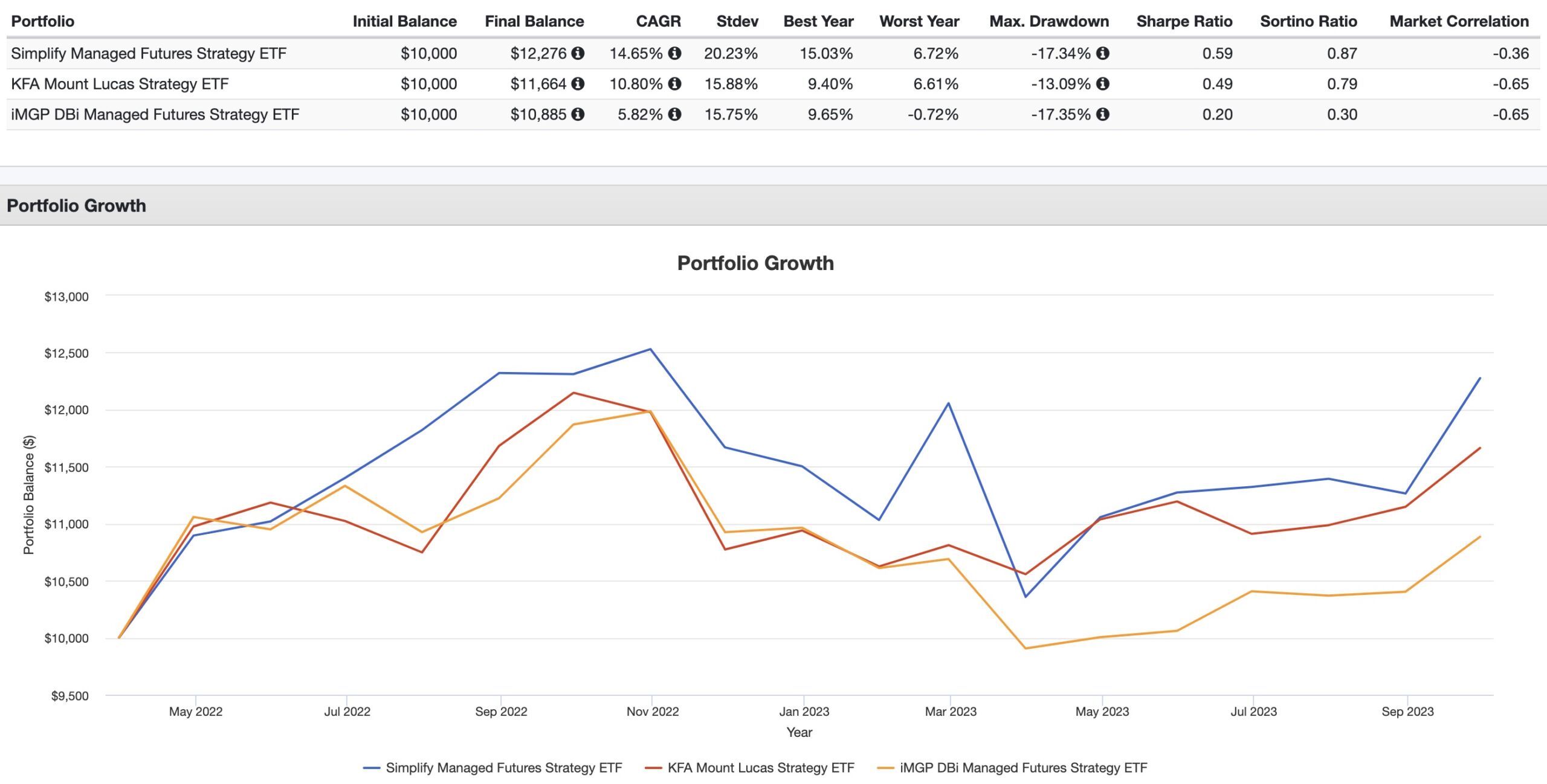
That’s mighty impressive!
And today we’re joined by Larry Kim of Simplify to find out more about the fund.
Without further ado, let’s turn things over to Larry!

Meet Larry Kim of Simplify
Larry works with financial advisors and institutional investors on understanding the Simplify product lineup, with a special emphasis on creating written and video content. Previously, he was a senior consultant at Fidelity Institutional, where he advised large banks and insurance companies on how to set up and optimize their managed account programs. He also held roles in mutual fund product management and development as well as financial planning.
Larry has an MBA from the Leonard N. Stern School of Business at New York University and a bachelor’s degree from Oberlin College.

Reviewing The Strategy Behind CTA ETF (Simplify Managed Futures ETF)
Hey guys! Here is the part where I mention I’m a travel content creator! This “The Strategy Behind The Fund” interview is entirely for entertainment purposes only. There could be considerable errors in the data I gathered. This is not financial advice. Do your own due diligence and research. Consult with a financial advisor.
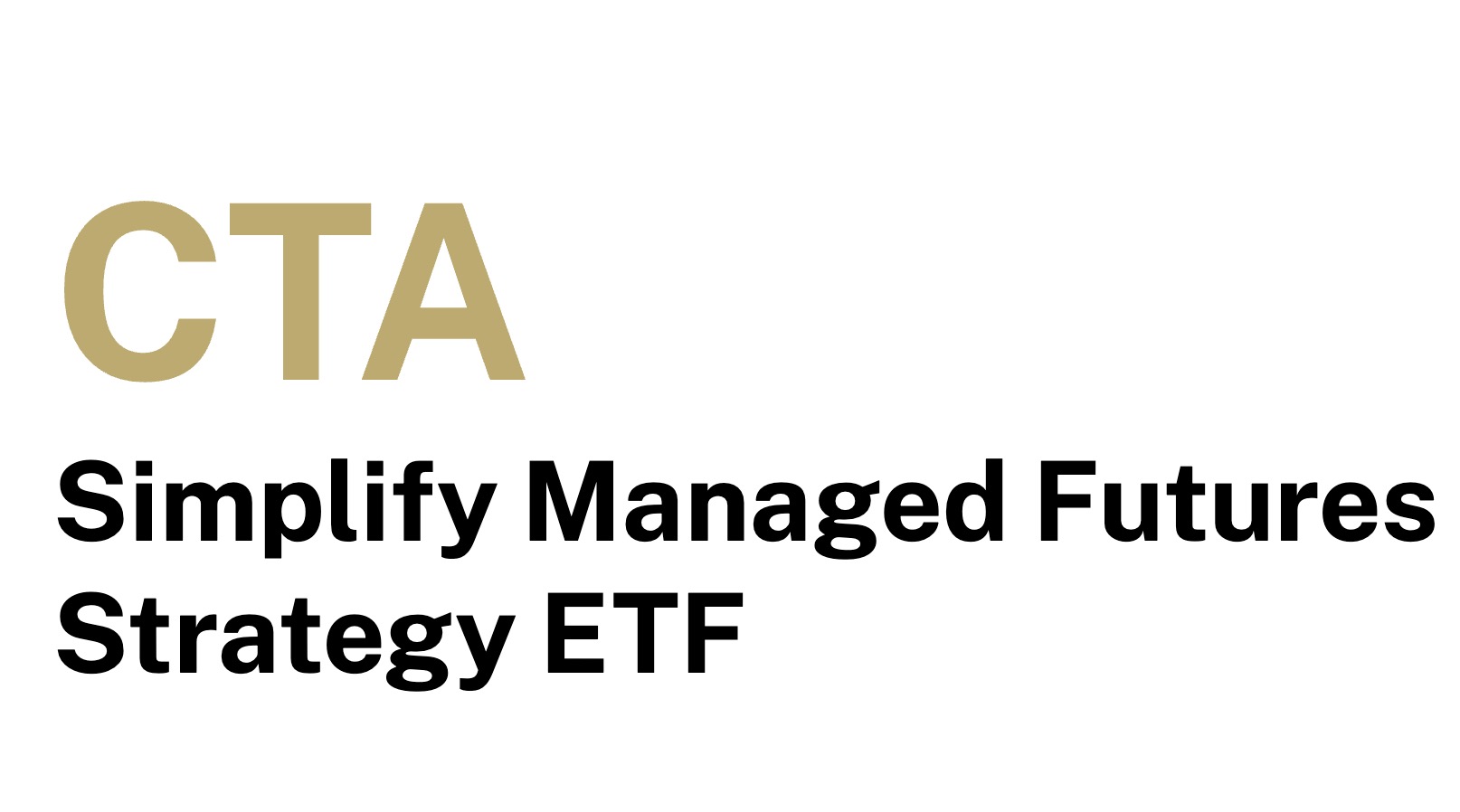
These asset allocation ideas and model portfolios presented herein are purely for entertainment purposes only. This is NOT investment advice. These models are hypothetical and are intended to provide general information about potential ways to organize a portfolio based on theoretical scenarios and assumptions. They do not take into account the investment objectives, financial situation/goals, risk tolerance and/or specific needs of any particular individual.

What’s The Strategy Of CTA ETF?
For those who aren’t necessarily familiar with a “‘managed futures” style of asset allocation, let’s first define what it is and then explain this strategy in practice by giving some clear examples.
Managed Futures is a category of investment strategies that generally involve going long (or short) a basket of asset classes such as equities, interest rates, commodities and or currencies. Futures contracts are used as the underlying instruments. Trend following (or momentum) is the most commonly used investing strategy, with funds going long assets that are trending upwards and shorting assets that are trending downwards.
The investing case for managed futures is portfolio diversification. Most traditional portfolios invest in stocks and bonds. The idea is that bonds offer diversification from stocks and should provide a buffer against stock market volatility and drawdowns. However, as we saw in 2022, stocks and bonds are sometimes positively correlated. Managed futures have historically had little to no correlation with either stocks or bonds. They would have added significant value during periods of serious stock market drawdowns.
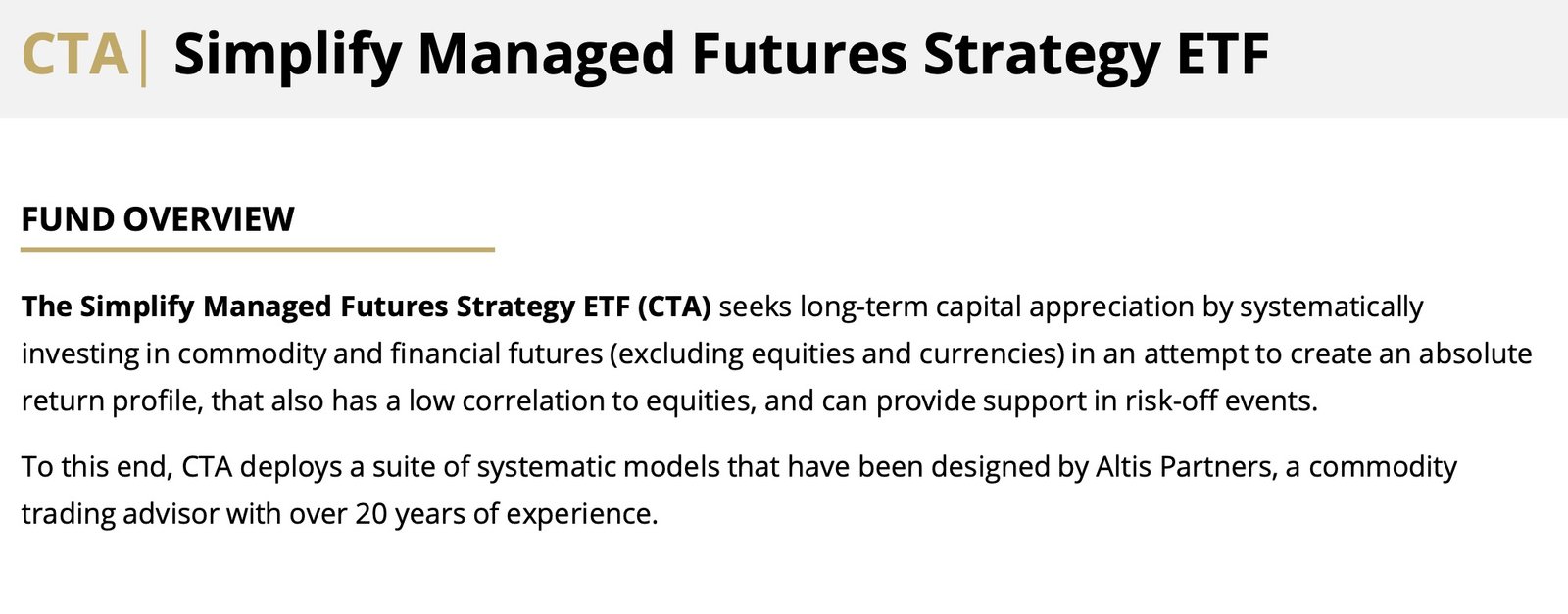
Unique Features Of Simplify Managed Futures Fund CTA ETF
Let’s go over all the unique features your fund offers so investors can better understand it. What key exposure does it offer? Is it static or dynamic in nature? Is it active or passive? Is it leveraged or not? Is it a rules-based strategy or does it involve some discretionary inputs? How about its fee structure?
Simplify Managed Futures Strategy ETF (CTA) offers exposure to interest rates and commodity futures. Specifically, it can take positions in 15 different futures contracts across US and Canadian interest rates, precious metals, industrial metals, energy or agriculture.
It’s managed systematically, using an algorithmic model developed by our research partner Altis Partners, a leading commodity trend advisor with more than 20 years in the space.
Positions are dynamically adjusted according to a daily trading signal. The signal can trigger a long or short position in an asset.
Like all strategies that invest in futures contracts, there is a degree of leverage involved, but it is limited to the fund’s regulatory requirements.
Signals generated by the algorithm are traded systematically. They are executed by Simplify’s portfolio managers regardless of their personal opinions on any particular asset.
Fund expenses are 0.75%. Lastly, it’s structured as a 1940 Act fund, so investors receive a 1099 tax form instead of a K-1.
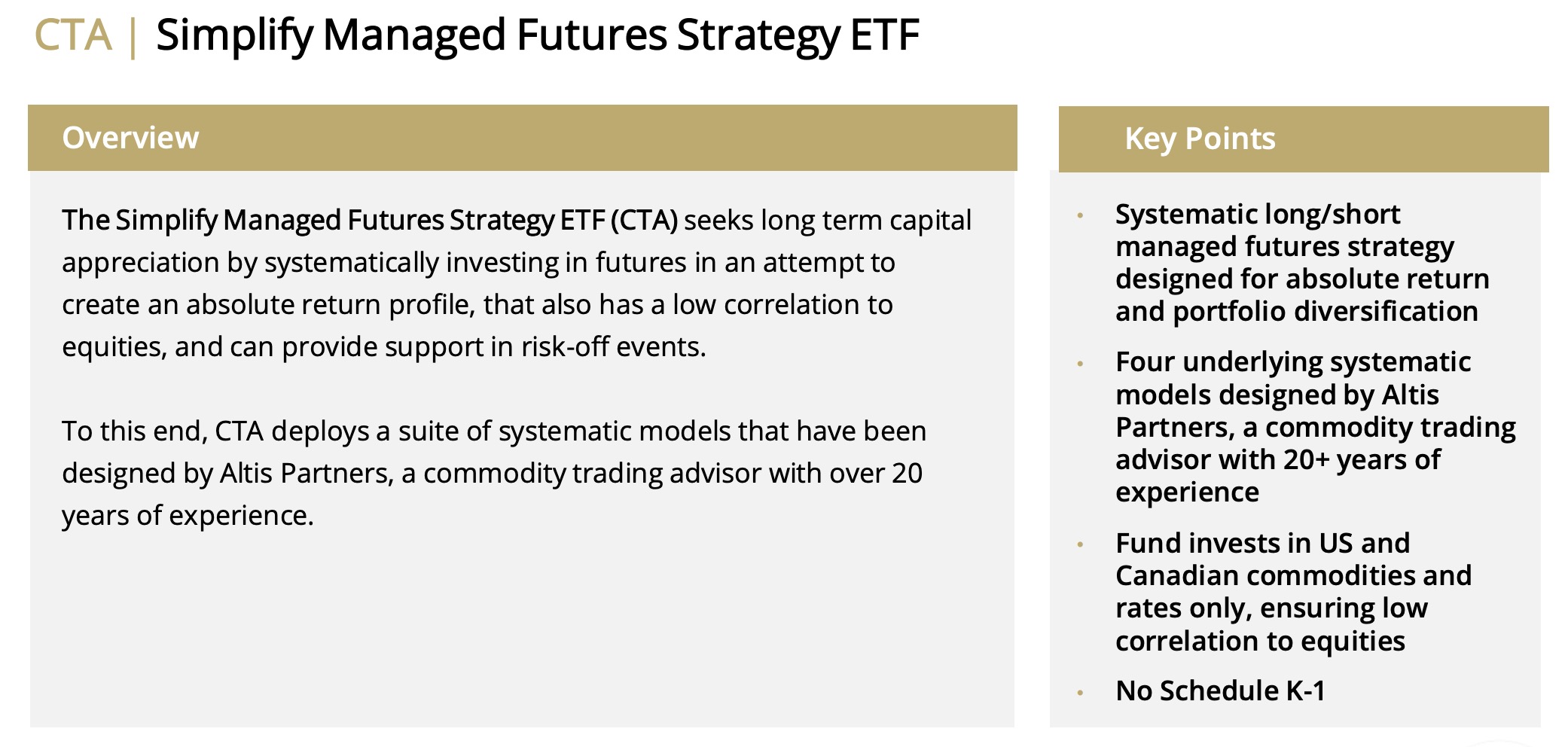
What Sets CTA ETF Apart From Other Alternative Funds?
How does your fund set itself apart from other “managed futures” funds being offered in the ETF marketplace? What makes it unique?
The Simplify Managed Futures Strategy ETF (CTA) has several unique features.
First, it only takes positions in interest rate and commodity futures – excluding equities and currencies. According to our research, trend following strategies exhibit higher risk adjusted returns when applied to interest rate and commodity futures than they do with equities and currencies.
Furthermore, by excluding equities, correlations are kept as low as possible, adding to its diversification value.
Next, unlike most managed futures strategies that exclusively rely on trend following, Simplify adds a “fundamental reversion” factor to reduce risk. A very strong trend signal would indicate going long/short an asset in a big way. This can expose the fund to significant risk in the case of a sharp reversal, which is all too common with commodities futures. If a sharp trend moves an asset price well beyond what its indicated fair value price (using fundamental indicators) should be, the fundamental reversion indicator will take some of the risk off a trade.
Lastly, most managed futures funds rebalance weekly. That is, they use their signals to adjust their positions once per week. Simplify is one of the few – if not the only – managed futures ETF that incorporates daily rebalancing, which may enable it to enter/exit positions at a more advantageous point.
source: Simplify Asset Management on YouTube

What Else Was Considered For CTA ETF?
What’s something that you carefully considered adding to your fund that ultimately didn’t make it past the chopping board? What made you decide not to include it?
When deciding on the potential universe of futures contracts to take positions in, we were faced with hundreds of possible choices. Ultimately, we decided to limit the investment universe to a carefully curated set of 15 contracts. The contracts were selected with the goals of having an adequate representation across interest rates and commodities while also making it as easy as possible for market makers to trade, which adds to the fund’s liquidity.


When Will CTA ETF Perform At Its Best/Worst?
Let’s explore when your fund/strategy has performed at its best and worst historically or theoretically in backtests. What types of market conditions or other scenarios are most favourable for this particular strategy? On the other hand, when can investors expect this strategy to potentially struggle?
Like all trend following strategies, CTA will perform the best when there are significant market trends in place, either up trends or downtrends. It will tend to struggle the most in a trendless, choppy market environment.

Why Should Investors Consider Simplify Managed Futures Fund CTA ETF?
If we’re assuming that an industry standard portfolio for most investors is one aligned towards low cost beta exposure to global equities and bonds, why should investors consider your fund/strategy?
In 2022, the 60/40 portfolio had its worst year in over 50 years, as both stocks and bonds exhibited double digit negative returns.
Managed futures, on the other hand, exhibited one of its best years as an asset class.
A portfolio containing only stocks and bonds is like a two-legged stool – not particularly stable. Adding managed futures to a portfolio adds a third leg to the stool, making it much more stable.
There are three reasons managed futures are such an effective diversifier:
- They add an additional asset class – particularly commodities – that most investors are not exposed to.
- They add the ability to go both long and short, which adds diversification to portfolios which are traditionally long-only.
- They add a different return driver – trend following – which is typically not present in most portfolios.

How Does CTA ETF Fit Into A Portfolio At Large?
Let’s examine how your fund/strategy integrates into a portfolio at large. Is it meant to be a total portfolio solution, core holding or satellite diversifier? What are some best case usage scenarios ranging from high to low conviction allocations?
When you add managed futures to a portfolio of stocks and bonds, a 50% allocation to manage futures has maximized returns, while a 40% allocation has maximized risk adjusted returns. If an investor’s goal was to optimize a portfolio, a 40-50% allocation is reasonable.
However, many investors – particularly investment professionals – have other goals beyond portfolio optimization. They must also be cognizant of tracking error, as excessive tracking error to traditional benchmarks can introduce business risk. In other words, it’s safer to be with the crowd. For these investors, a 10-20% allocation would still add to returns and reduce volatility while maintaining an acceptable level of tracking error.

The Cons of CTA ETF
What’s the biggest point of constructive criticism you’ve received about your fund since it has launched?
One debate in the managed futures world is whether it’s better to invest in a single manager strategy or to invest in a “replication” strategy, which attempts to reverse-engineer and replicate the returns of the total managed futures marketplace.
While replication can have its place, it does have a few weaknesses. First, replication itself is not easy, with many different strategies that could potentially be applied. There’s no guarantee that any particular strategy can successfully represent the benchmark. Secondly, replication can be a very slow moving strategy, with replication funds taking positions weeks after underlying funds have moved. CTA, on the other hand, can process new signals on a daily basis.

The Pros of CTA ETF
On the other hand, what have others praised about your fund?
CTA, launched in March 2022, has gotten off to a great start, significantly outperforming its benchmark since launch.
source: Simplify Asset Management on YouTube
Learn More About CTA ETF
We’ll finish things off with an open-ended question. Is there anything that we haven’t covered yet that you’d like to mention about your fund/strategy? If not, what are some other current projects that you’re working on that investors can follow in the coming weeks/months?
As we discussed previously, managed futures perform best in trending markets. But another environment where they are expected to perform well is during inflationary markets. That’s because they usually are accompanied by significant trend opportunities in commodities (up or down).
At Simplify, we continue to focus on bringing institutional-quality alternative strategies to all investors in the convenient ETF format. In today’s environment of high equity valuations, potential for recession, and interest rate volatility, we believe it’s smart to focus on alternative sources of returns and income.
To learn more about Simplify or to speak with a Simplify representative, please go to simplify.us. You can also follow us on YouTube at https://www.youtube.com/@SimplifyAssetManagement

Connect With Simplify ETFs
Twitter: @SimplifyAsstMgt
YouTube: Simplify Asset Management
Simplify Asset Management: Simplify ETFs
Fund Page: CTA ETF
Nomadic Samuel Final Thoughts
I want to personally thank Larry Kim at Simplify for taking the time to participate in “The Strategy Behind The Fund” series by contributing thoughtful answers to all of the questions!
If you’ve read this article and would like to have your fund featured, feel free to reach out to nomadicsamuel at gmail dot com.
That’s all I’ve got!
Ciao for now!
Important Information
Comprehensive Investment Disclaimer:
All content provided on this website (including but not limited to portfolio ideas, fund analyses, investment strategies, commentary on market conditions, and discussions regarding leverage) is strictly for educational, informational, and illustrative purposes only. The information does not constitute financial, investment, tax, accounting, or legal advice. Opinions, strategies, and ideas presented herein represent personal perspectives, are based on independent research and publicly available information, and do not necessarily reflect the views or official positions of any third-party organizations, institutions, or affiliates.
Investing in financial markets inherently carries substantial risks, including but not limited to market volatility, economic uncertainties, geopolitical developments, and liquidity risks. You must be fully aware that there is always the potential for partial or total loss of your principal investment. Additionally, the use of leverage or leveraged financial products significantly increases risk exposure by amplifying both potential gains and potential losses, and thus is not appropriate or advisable for all investors. Using leverage may result in losing more than your initial invested capital, incurring margin calls, experiencing substantial interest costs, or suffering severe financial distress.
Past performance indicators, including historical data, backtesting results, and hypothetical scenarios, should never be viewed as guarantees or reliable predictions of future performance. Any examples provided are purely hypothetical and intended only for illustration purposes. Performance benchmarks, such as market indexes mentioned on this site, are theoretical and are not directly investable. While diligent efforts are made to provide accurate and current information, “Picture Perfect Portfolios” does not warrant, represent, or guarantee the accuracy, completeness, or timeliness of any information provided. Errors, inaccuracies, or outdated information may exist.
Users of this website are strongly encouraged to independently verify all information, conduct comprehensive research and due diligence, and engage with qualified financial, investment, tax, or legal professionals before making any investment or financial decisions. The responsibility for making informed investment decisions rests entirely with the individual. “Picture Perfect Portfolios” explicitly disclaims all liability for any direct, indirect, incidental, special, consequential, or other losses or damages incurred, financial or otherwise, arising out of reliance upon, or use of, any content or information presented on this website.
By accessing, reading, and utilizing the content on this website, you expressly acknowledge, understand, accept, and agree to abide by these terms and conditions. Please consult the full and detailed disclaimer available elsewhere on this website for further clarification and additional important disclosures. Read the complete disclaimer here.






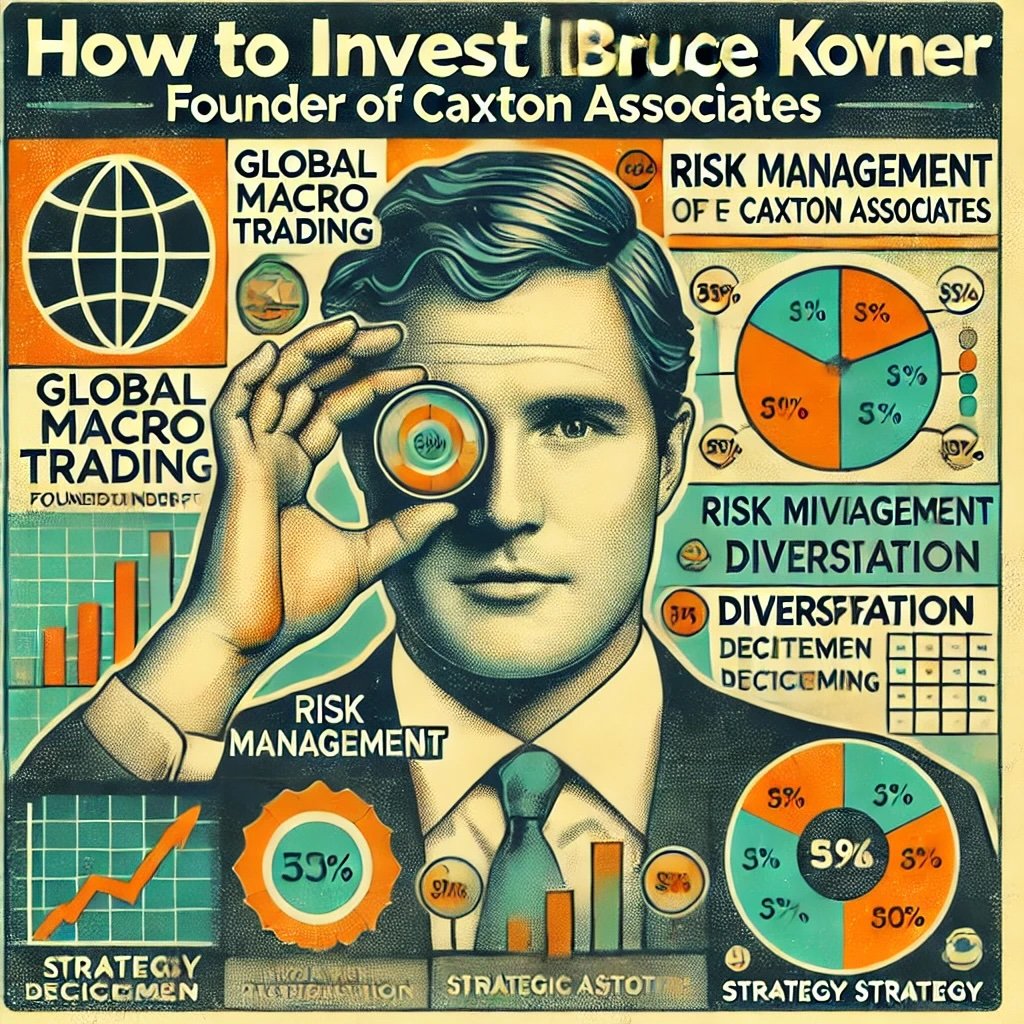
Blndx far superior…